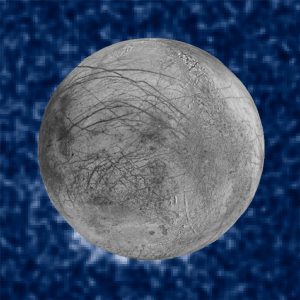
 Astronomers using NASA’s Hubble Space Telescope have imaged what may be water vapor plumes erupting off the surface of Jupiter’s moon Europa. This finding bolsters other Hubble observations suggesting the icy moon erupts with high-altitude water vapor plumes.
Astronomers using NASA’s Hubble Space Telescope have imaged what may be water vapor plumes erupting off the surface of Jupiter’s moon Europa. This finding bolsters other Hubble observations suggesting the icy moon erupts with high-altitude water vapor plumes.
The observation increases the possibility that missions to Europa may be able to sample Europa’s ocean without having to drill through miles of ice.
“Europa’s ocean is considered to be one of the most promising places that could potentially harbor life in the solar system,” said Geoff Yoder, acting associate administrator for NASA’s Science Mission Directorate in Washington, D.C. “These plumes, if they do indeed exist, may provide another way to sample Europa’s subsurface.”
The plumes are estimated to rise about 125 miles before, presumably, raining material back down onto Europa’s surface. Europa has a huge global ocean containing twice as much water as Earth’s oceans, but it is protected by a layer of extremely cold and hard ice of unknown thickness. The plumes provide a tantalizing opportunity to gather samples originating from under the surface without having to land or drill through the ice.
The team, led by William Sparks of the Space Telescope Science Institute (STScI) in Baltimore, Maryland, observed these finger-like projections while viewing Europa’s edge as it passed in front of Jupiter.
The original goal of the team’s observing proposal was to determine whether Europa has a thin, extended atmosphere, or exosphere. Using the same observing method that detects atmospheres around planets orbiting other stars, the team also realized if there was water vapor venting from Europa’s surface, this observation would be an excellent way to see it.
“The atmosphere of an extrasolar planet blocks some of the starlight that is behind it,” Sparks explained. “If there is a thin atmosphere around Europa, it has the potential to block some of the light of Jupiter, and we could see it as a silhouette. And so we were looking for absorption features around the limb of Europa as it transited the smooth face of Jupiter.”
In 10 separate occurrences spanning 15 months, the team observed Europa passing in front of Jupiter. They saw what could be plumes erupting on three of these occasions.
This work provides supporting evidence for water plumes on Europa. In 2012, a team led by Lorenz Roth of Southwest Research Institute in San Antonio, Texas, detected evidence of water vapor erupting from the frigid south polar region of Europa and reaching more than 100 miles into space. Although both teams used Hubble’s Space Telescope Imaging Spectrograph (STIS) instrument, each used a totally independent method to arrive at the same conclusion.
“When we calculate in a completely different way the amount of material that would be needed to create these absorption features, it’s pretty similar to what Roth and his team found,” Sparks said. “The estimates for the mass are similar, the estimates for the height of the plumes are similar. The latitude of two of the plume candidates we see corresponds to their earlier work.”
If confirmed, Europa would be the second moon in the solar system known to have water vapor plumes. In 2005, NASA’s Cassini orbiter detected jets of water vapor and dust spewing off the surface of Saturn’s moon Enceladus.


Be the first to comment